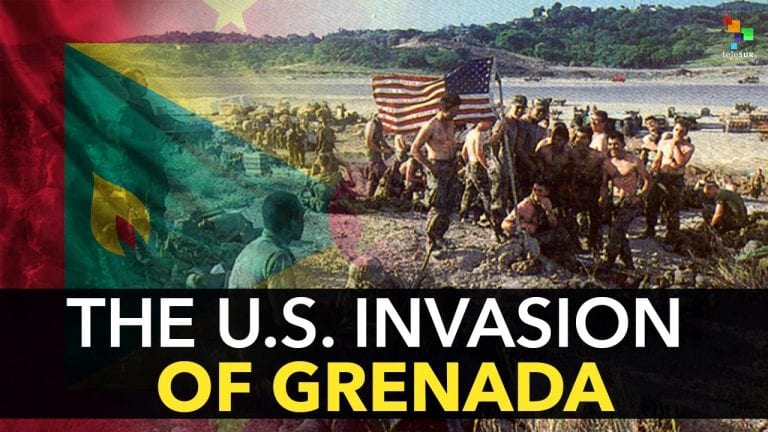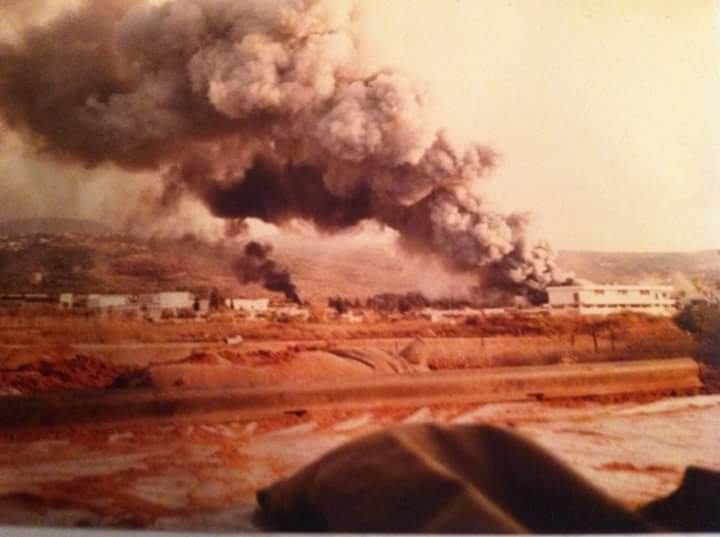The Grenadian leader, Maurice Bishop was deposed and executed on October 19, 1983. Six days later the US invaded, with the proffered reason that the American medical students studying in the Grenada were in danger due the Cuban presence. The CIA installed a new leader supported by the US.
The following is from Canadian author Richard Sanders first published in May 2002, prior to the onslaught of the Iraq war, carefully documents the History of War Pretext Incidents.
For decades, Eric Gairy dominated the tiny British colony of Grenada. Gairy “a vicious dictator…[was] the only Caribbean leader to maintain diplomatic relations with Pinochet’s Chile.” When his “notorious security forces” returned from training in Chile “‘disappearances’ became frequent.” ‘Gariyism’ was so bad that when Britain offered independence, Grenadans united to “shut down the country…prior to Independence Day, February 7, 1974.”
The New Jewel Movement (NJM) led a successful uprising on March 13, 1979. The NJM “organized agrarian reform…, expanded trade union rights, advanced women’s equality…, established literacy programs and instituted free medical care.”
The CIA “relentlessly used every trick in its dirty bag” including “an unending campaign of economic, psychological and openly violent destabilization.” Reagan met Caribbean leaders, the US urged “regional governments to consider military action” and CIA chief, William Casey, met Senate Intelligence Committee members “to discuss CIA involvement.” Gairy began “recruiting mercenaries from…the Cuban exile community in Miami.” (ER BS p.3-5)
In October 1981, a US military exercise simulated an invasion of Grenada ostensibly to rescue Americans and “install a regime favorable to the way of life we espouse.”
In March 1983, Reagan exclaimed on TV that Grenada’s tourist airport threatened US oil supply routes.
On October 19, 1983, NJM leader Maurice Bishop, and others, were put under house arrest during a coup by NJM’s Deputy PM Bernard Coard. Oddly, they were freed by a “well organized crowd…including counter-revolutionary elements…with anti-communist banners…. [led by] well known businessmen…. Who organized this rally, planned so well, and in advance?” Freed NJM leaders were whisked away and as a “crowd gathered…the soldiers, apparently panicked by explosions, opened fire.… something provoked them, leading to a massacre.” NJM leaders surrendered to soldiers and were soon executed.
Significantly, “Pentagon officials informed Members of Congress that they had known of the impending coup…two weeks in advance.”
The coup plotters were charged with the murders but their lawyer, former US Attorney General Ramsey Clarke believe them innocent of the murders. It seems the coup was hijacked by US interests to kill some NJM leaders, jail the rest and set the stage for an invasion.
PRETEXT In his Naval Science course, Captain M.T.Carson lists the invasion’s “stated reasons” as “protect Americans, eliminate hostage potential; restore order; requested by OECS [Organization of Eastern Caribbean States].”
The US helped form the OECS, and then got it and the Grenadan governor to “request” an invasion. Under “potential problem,” Carson notes “Act fast with surprise and present world with fait accompli. If not, world opinion of U.S. invasion of tiny country will be critical. So: · “Get OECS to request action.” · “Get Governor Scoon to request action.” · “Emphasize students-in-danger aspect”
Carson quotes a “medical school official”: “Our safety was never in danger. We were used as an excuse by this government to invade…. They needed a reason…and we were it.” MTC Most students “insisted” that they were “not…in any danger before the US invasion; only afterwards.”
RESPONSE On October 22, 1983, “Operation Urgent Fury” was ordered. Three days later, the invasion hit like a cyclone.
The Organization of American States “deeply deplored” the invasion and the UN Security Council voted 11 to 1 against it.
REAL REASONS Grenada threatened the US by providing a powerful example of viable alternative ways to organize social, political and economic structures.
Carson lists these reasons: · “Chance to eliminate Communist regime and replace with pro-U.S. government” · “Demonstrate U.S. military capabilities” · “President Reagan commented that U.S. military forces were back on their feet and standing tall.”
US military morale was damaged two days before the invasion when 241 Marines were killed in Lebanon.
The Wall Street Journal said the invasion made Grenada a “haven for offshore banks.”
From the book ‘The CIAs Greatest Hits‘ by Mark Zepezauer:
Here’s what the US public was told: President Reagan woke up one day to discover that a horrible Marxist coup had taken over the Caribbean island of Grenada. Because there were Cuban troops on the island, the president had to send the US military to rescue US citizens trapped there and held as virtual hostages.
There was no way to get a more accurate picture, since the US military kept reporters from setting foot on Grenada during the invasion; a boatload of US journalists was turned away at gun point and all flights in and out were canceled. Much later, long after everyone had stopped paying attention to Grenada, it became clear that the official story was built on a mountain of lies.
The CIA began destabilizing Grenada in 1979, when a man named Maurice Bishop ousted the eccentric thug who ruled the island. Bishop set to work developing a better life for Grenada’s citizens and earned much popular support for doing so. He ran afoul of the US fairly quickly, though, when he failed to join in the quarantine of Cuba.
Bishop’s mildly socialist program (private enterprise left unmolested, but free health care, school lunches, etc.) was the final straw. Before long, a CIA propaganda campaign was portraying Grenada as a terrorist state allied to the Soviet Union, its 100,000 inhabitants armed to the teeth and poised to attack the pitifully vulnerable US.
The US invasion was planned at least two years before it happened, and CIA acts of sabotage proliferated. Money was given to opposition politicians and neighboring armies. Finally, in late 1983, Bishop was overthrown by extremists in his own party and executed, and the US invasion began. CIA agents among the “hostages” helped coordinate the three-day war over shortwave radio.
As for the Cuban troops we invaded to protect our citizens from, there were 43 of them; the other Cubans on Grenada were mostly middle-aged construction workers. The Cubans let it be known that they would not interfere with the US “rescue,” but the US troops fired on them and they defended themselves. That night, the US assured Cuba that its citizens in Grenada were “not a target”; the next day, we attacked them with helicopter gunships. When it was all over, 81 Cubans, 296 Grenadines and 131 Americans had been killed or wounded.
BAR executive editor Glen Ford concludes his article ‘Remember the Grenada Invasion‘ with the following:
The Grenadian armed forces put up what resistance they could, given the overwhelming firepower and numbers of the enemy and the fratricidal trauma the Grenadian nation had just undergone. However, the superpower could not allow itself to be seen as an elephant stomping on a flea. Therefore, all dead bodies recovered on the island were initially designated as “Cuban,” except for the 21 patients and staff killed in the U.S. bombing of the mental hospital, at St. George’s, in the first day of the invasion. The official line, dutifully parroted by the press, was that only Cuban soldiers – 1,100 of them – had resisted the American assault. In fact, Cuban nationals on the island numbered only about 700, most of them unarmed, pot-bellied construction workers. Cuban military personnel defended only their embassy. Twenty-four Cubans died in the early days of the invasion, along with probably several hundred Grenadian military. But, for weeks, the Americans claimed to be chasing an elusive force of Cuban super-soldiers around island. The New York Times relayed a U.S. military estimate that 500 Cubans had “fled into the hills.” These phantom Cubans live on in the 1986 Clint Eastwood movie Heartbreak Ridge, in which Eastwood and his platoon do battle with Castro’s men in the hills of the island. (For Fidel Castro’s remarks at the funeral of Cuba’s real-life casualties in Grenada, click HERE.)
By November 13, three weeks into the invasion, the New York Times was still reporting that Grenadians have been passive in the invasion of their own country. “Grenadians Toll Put by U.S. at 21: Americans Appear to Believe that All Combatants Killed in Battle Were Cubans.” The bombing of the mental hospital, where the only acknowledged Grenadian fatalities occurred, was an “accident,” said the Reagan administration. Indeed, the U.S. action was not an “invasion” at all, but an “intervention.” The New York Times loyally purged “invasion” from its vocabulary until the last phantom Cuban disappeared from the Grenadian hills.
The Grenada invasion was, in a sense, simply a continuation of U.S. “gunboat diplomacy” in the Western Hemisphere, as was practiced as late as 1965, in the invasion-intervention of the Dominican Republic, which was also undertaken under the hybrid rationales of “not another Cuba” and “rescue of American nationals.” However, Grenada may have been the first U.S. occupation in which members of the native government and armed forces that had evaded death or capture were immediately dubbed “fugitives” – outlaws in their own land, where they had been the lawful and recognized authority, only days before.
Today, the airport at Point Salines that represented such an imminent threat to U.S. national security is named for martyred Prime Minister Maurice Bishop, the revolutionary who was the villain of Ronald Reagan’s mock attack on “Amber and the Amberdines,” but whose death provided the opportunity for the actual invasion of his homeland.
https://www.youtube.com/watch?v=FifGWyxdV3c
Additional Information:




